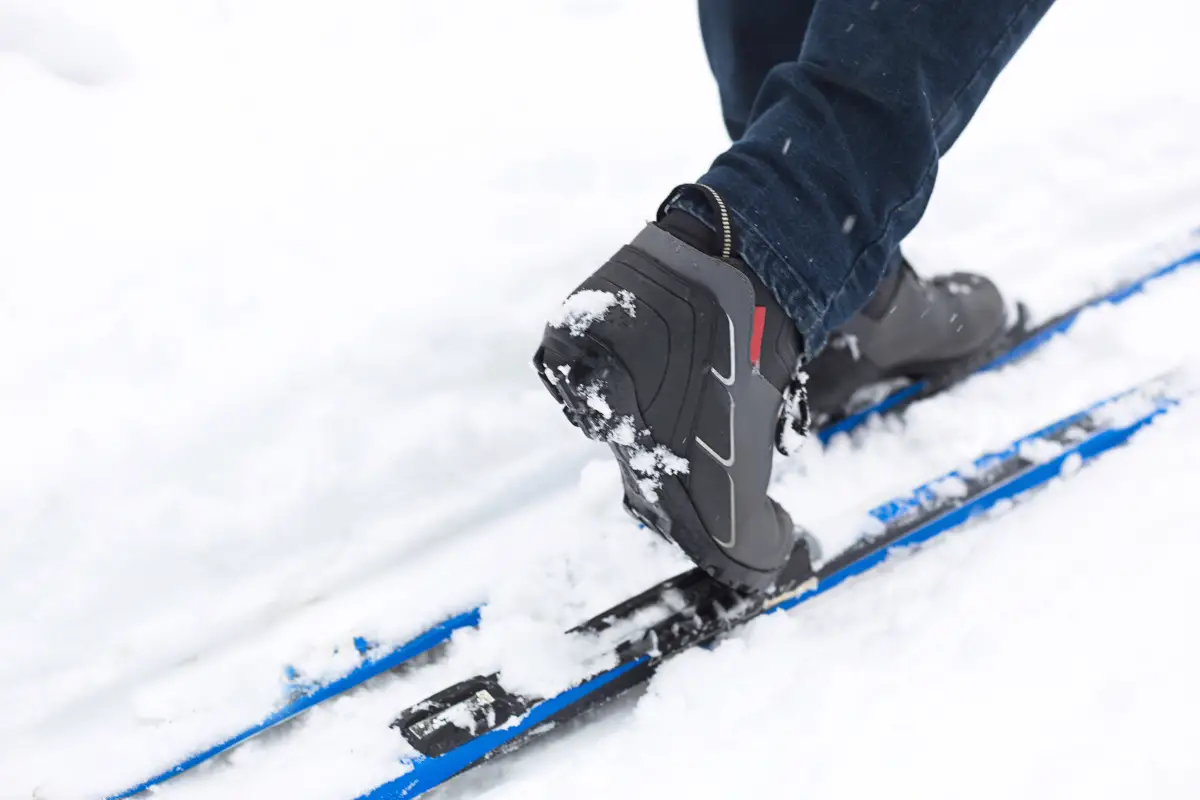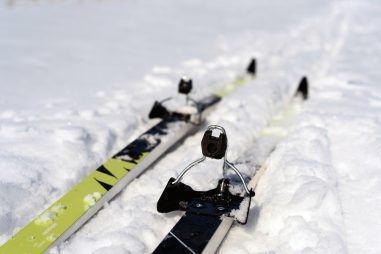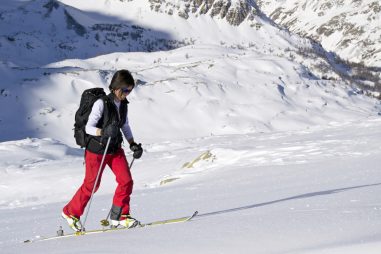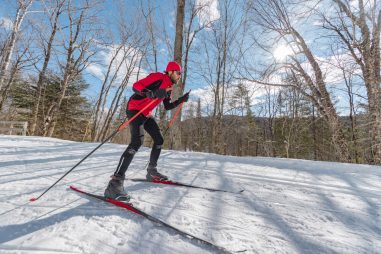Choosing cross country ski boots isn’t as simple as choosing downhill ski boots. Cross country skiing’s different techniques have specific boots designed for each.
Then you also need to have compatible bindings for your chosen boots. It may sound complicated to find the right pair, but this guide should make it easier for you.
We’ve detailed the different boots needed for each cross country skiing style. This will help you find the right type. And because the fit determines comfort, we’ve also included pointers on how to choose your size. This way, you’ll get to enjoy cross country skiing every time.
Do You Need Special Boots for Cross Country Skis?
For cross country skiing, you need boots made specifically for this type of skiing. The design and purpose differ compared to your downhill skiing boots.
Cross country ski boots aren’t as rigid and are only connected to your skis on the front part. The detached heel is what makes it possible to walk or go uphill with cross country skis.
Can You Wear Normal Boots With Cross Country Skis?
You can’t wear normal boots with cross country skis. The design, construction, and materials all differ. Normal ski boots fully connect your foot to the ski. So it doesn’t allow you to make the same movements in cross country skiing. They’re completely different from how cross country ski boots should function.
Are Cross Country Ski Boots the Same as Downhill Ski Boots?
Cross country ski boots are not the same as downhill ski boots. The type of skiing is different so it requires a different set of equipment.
Cross country skis allow you to slide and glide on flat terrain. You can also go uphill and ski downhill. As for downhill ski boots, you can only use them for downhill skiing.
Cross Country Ski Boots vs. Downhill Ski Boots
Here are the differences between cross country ski boots and downhill ski boots:
Cross country ski boots connect to your ski on your foot’s front end with the heel detached. This is what makes it possible to ski on different terrains and then go uphill. They’re also made of softer materials and thus more flexible. That’s essential so you can execute cross country skiing movements properly.
Meanwhile, downhill ski boots connect your foot completely to your skis. Aesthetically, they’re chunkier than their cross country skiing counterparts. Your entire foot is connected to the ski and it provides more stability and control at high speeds. But it’s also this reason which makes it impossible to cross country ski with downhill ski boots.
What Are the Different Types of Cross Country Ski Boots?
With different types of cross country skiing come different boots to fit each one. Here are the various cross country boot types:
- Classic Cross Country Ski Boots: This technique is similar to walking. That’s why these boots are softer to allow your foot to flex as you slide your foot forward. They’re also generally wider for more comfort, making them ideal for groomed tracks.
- Cross Country Skating Boots: Your movements are more dynamic with this style. Because it’s like skating, the boots are more lightweight and firm. This gives your feet more support each time you push off. While they aren’t as comfortable as classic boots, the minimal flex helps you perform better.
- Cross Country Combi Boots: These are designed for both the classic and skating styles. They have the best of both boot types, making it ideal for anyone who loves mixing up styles every now and then.
- Cross Country Racing/Performance Boots: These boots are for the highest levels of cross country skiing. Competitive skiers or pro athletes need high-performance boots. Racing boots are the most lightweight and have a lower cuff for more range of motion. However, they still provide great support and comfort.
- Backcountry/Touring Cross Country Boots: Backcountry terrain can be unpredictable. That’s why you need boots with a great combination of flexibility and rigidity. You need flexibility for striding and rigidity when making turns or stops. They’re designed for comfort, insulation, and snow protection.
Cross Country Ski Boots NNN vs. SNS Style
Cross country boot soles come in different styles; the NNN and SNS are the most popular.
NNN stands for New Nordic Norm and SNS is the Salomon Nordic System. These categorize how your boots connect and match with the binding’s configuration. This affects the grip and the control you have over your skis.
These two systems aren’t compatible with each other. So you need specific bindings that work with your boot style.
What Are NNN Cross Country Ski Boots?
NNN cross country boots have two main characteristics. The first is the single bar at the toe and the second is the two main channels that line up with the binding’s ridges. These boots come in the backcountry and nonbackcountry configurations. So you have to check what you’re getting since they aren’t compatible with each other.
NNN boots are compatible with the following bindings: NNN, NIS, Prolink, and Turnamic.
Cross Country Ski Boots Classic vs. Skate Ski Boots
Because classic and skate are different techniques, they have different boot requirements.
Classic boots are more flexible than ski boots. Your feet need to flex as you execute the slide and glide movements. Ski boots are more rigid due to the more dynamic movements. You generate power as you push your body forward, and the rigid structure keeps your foot in place.
Ski boots also have a higher cuff to stabilize your ankle and prevent injuries. Classic boots have a lower cuff since you need more flexibility and range of movement.
What Are 3-Pin Cross Country Ski Boots?
Three-pin cross country boots connect with the binding through 3 pins found at the front. The boot has a wide front, kind of like a duckbill. At the bottom, you’ll find three holes that line up with the three pins on the binding.
What Kind of Boots Do You Need for Cross Country Skis?
For cross country skiing, you’ll need boots that have a heel-free design. These boots attach to the bindings at the front, leaving your heel detached. This design allows you to ski on groomed or ungroomed tracks, uphill or downhill.
Are Cross Country Ski Boots Universal?
Cross country boots aren’t universal. Different cross country styles call for their own boots that fit the technique. They also have unique ways of connecting with the binding. That’s why it’s so important to check for compatibility.
Do All Cross Country Ski Boots Fit All Bindings?
Cross country boot styles don’t fit all bindings. Certain styles are compatible with their corresponding bindings. The table below shows the compatibility:
| Boot Sole | Compatible Bindings |
| NNN | NNN, NIS, Turnamic, ProLink |
| SNS Profil | SNS Profil |
| SNS Pilot | SNS Pilot |
Are Cross Country Ski Boots Unisex?
Some cross country boots are unisex while others are gender-specific. Yet sometimes you won’t be able to distinguish based on the design alone. So you need to check the product details if boots are unisex or for a specific gender.
What Is the Difference Between Men’s and Women’s Cross Country Ski Boots?
The difference between men’s and women’s cross country boots is in their weight and size.
Women generally have a smaller body size so their boot weight and size are more proportional to their bodies. Heavy boots will cost more effort for women to use.
And since men tend to have bigger feet, it should also be proportional to the skis they’re using. So the wide skis engineered for the male body need bigger boots. And so the thinner skis for women will require smaller boot sizes.
How Should My Cross Country Ski Boots Fit?
Getting the right boot size will make for a great skiing experience. The right fit will keep your feet stable, comfortable, and warm throughout your ride. It will also help you get the best performance out of your skis.
Are Cross Country Ski Boots Supposed to Be Tight or Loose?
Between the two, it would be better if your cross country boots are tight, but not too tight. A snug fit is ideal.
Getting a bigger size runs the risk of your foot sliding inside. This can make you lose your balance and make it difficult to maneuver. Not to mention the blisters that you can get.
If it’s too tight, it can be a painful experience. It can restrict blood flow and can be uncomfortable.
When it’s snug, it’s tight but not uncomfortable. It secures your foot and won’t loosen anytime during your ride.
How Do You Know If Cross Country Ski Boots Fit?
You can check the following to know if your cross country boots have a perfect fit:
- It should be comfortable around the widest part of your foot.
- Your toes shouldn’t be touching the front part of your boot. A little space is fine just as long as it isn’t too loose.
- As you ski, your heel should remain secure inside the boot. If it slides forward or upwards, your boots might be too big.
Before making a purchase, always try on the boots to find the snug fit that you need.
Do Cross Country Ski Boots Stretch?
Yes, your ski boots will stretch over time. Cross country boots have an inner liner that will have a snug fit. When you first wear your brand new boots, they’ll feel extra tight. But after they’ve been broken in, they’re designed to take the shape of your feet.
As for the outer part of the boot itself, only those with stiffer materials can be stretched. Boots for beginners or intermediate skiers usually have a soft material. These can no longer stretch as much.
But boots with stiffer material, such as those in the professional ranks, can be stretched.
How Do You Stretch Cross Country Ski Boots?
You can have your boots stretched by a professional boot fitter. They have the equipment needed to stretch your boots to the size and shape you desire. Unless you’re a true expert, don’t try stretching your boots on your own. Doing so without prior experience can damage your boots.
Do Cross Country Ski Boots Fit the Same as Shoes?
Cross country ski boots fit similarly to your sneakers or athletic shoes. So if you wear a size 9 tennis shoe, you can start trying on size 9 ski boots. However, ski boots come in European sizing, so you’ll need to convert your shoe size if you’re not from Europe.
Do Cross Country Ski Boots Come in Half Sizes?
Yes, cross country ski boots come in half sizes. But they’re European sizing which can make it a little confusing if you’re not used to it. Here’s a table of US sizing and its equivalent in European sizes.
| US Men’s Size | US Women’s Size | US Kids’ Size | European Size |
| 3 | 4 | 4 | 35 |
| 3.5 | 4.5 | 4.5 | 35.5 |
| 4 | 5 | 5 | 36 |
| 4.5 | 5.5 | 5.5 | 36.5 |
| 4.5 | 5.5 | 6 | 37 |
| 5 | 6 | 6.5 | 37.5 |
| 5.5 | 6.5 | 7 | 38 |
| 5.5 | 6.5 | 7.5 | 38.5 |
| 6 | 7 | 8 | 39 |
| 6.5 | 7.5 | – | 39.5 |
| 7 | 8 | – | 40 |
| 7.5 | 8.5 | – | 40.5 |
| 8 | 9 | – | 41 |
| 8.5 | 9.5 | – | 41.5 |
| 8.5 | 9.5 | – | 42 |
| 9 | 10 | – | 42.5 |
| 9.5 | 10.5 | – | 43 |
| 9.5 | 10.5 | – | 43.5 |
| 10 | 11 | – | 44 |
| 10.5 | 11.5 | – | 44.5 |
| 11 | 12 | – | 45 |
| 11.5 | 12.5 | – | 45.5 |
| 12 | 13 | – | 46 |
| 12.5 | 13.5 | – | 46.5 |
| 12.5 | – | – | 47 |
| 13 | – | – | 47.5 |
| 13.5 | – | – | 48 |
| 13.5 | – | – | 48.5 |
| 14 | – | – | 49 |
Should I Go Up a Size in Cross Country Ski Boots?
So now you’re at the shop and trying on different boots but you can’t seem to find the exact size for your feet … when this happens, it’s better to go a size down. Going a size up will make it too big for you and won’t keep your feet stable. You’ll have a hard time skiing and can cause blisters.
What Size Cross Country Ski Boots Do I Need?
Always go for the size that fits the widest part of your foot comfortably. And a snug fit is better. But the catch is cross country ski boots come in European sizes. So finding your size can be challenging if you’re not familiar with this sizing system.
That’s why it’s best to fit the boots to find the European size that gives a snug fit without being too tight.
How Much Are Cross Country Ski Boots?
You can find good quality entry-level adult cross country ski boots starting at $100. But if you’re a pro in need of high-performance boots, expect to pay upwards of $200. Prices depend on the brand, materials used, and boot features.
Where Can I Buy Cross Country Ski Boots?
Cross country boots are available in winter sports retail stores. You can choose to buy in-store or online. But because finding the right size can be tricky, it’s recommended that you fit before purchasing.
You can go online shopping once you’re already familiar with the brand and how their boots fit.
Where to Buy 3-Pin Cross Country Ski Boots
Three-pin cross country boots aren’t as popular or common, so you won’t always find them in many retailers. You’ll need to check specialty stores to find these boots.
What Kind of Cross Country Ski Boots Do I Need?
The type of cross country boots you need is dependent on the cross country style and the bindings.
You have the classic, skate, backcountry touring, and racing styles. You’ll need to wear boots designed for the style you’re practicing.
Your boots should also be compatible with your bindings. If you have NNN boots, you need to get either NNN, NIS, Turnamic, or ProLink bindings. For SNS Profil boots, it’s only compatible with the same bindings. The same goes for SNS Pilot boots.
How to Attach Cross Country Ski Boots to Bindings
Cross country boots connect with the bindings at the front part. That’s the only area where you’ll find the locking mechanism. You can attach your boots to the bindings manually or automatically.
Most bindings have a lever that locks your boot in place. This is the manual method. All you need to do is pull the lever to unlock, align your boot into the notch, then pull back the lever to lock.
Some bindings have an automatic locking system. For this system, step into the binding to align the boot with the notch. Press down on it and it should lock automatically.
Whether manual or automatic, you should hear a click that tells you that your boots are locked in place.
An important note: before stepping into your bindings, you need to clean the outsole. Remove any snow, ice, or mud by gently tapping one boot against the other.
How Do You Release Cross Country Ski Boots
Done skiing? Releasing your boots is as easy as putting them on. If your binding has a lever, push or pull the lever to release your boot. For an automatic system, you need to press down on the release button at the front part of the binding.
Are Cross Country Ski Boots Comfortable?
Cross country boots are designed for comfort since you’ll be on your feet the whole time you’re skiing. For the classic cross country technique, the boots allow your feet to flex and stretch. This makes the walking movements easier.
And when it comes to cross country skiing, you can ski as far as your body allows. This makes comfort essential. It’s hard to imagine skiing long distances with uncomfortable boots. You’ll end up hurting your feet.
Can You Walk in Cross Country Ski Boots?
Since you can detach your ski boots from your ski, it means you can walk on ski boots, right? Yes, you can walk using your cross country ski boots. There are even some brands that have designed their boots for use in the urban environment as well.
Is It Ok or Bad to Walk in Cross Country Ski Boots?
It’s ok to walk in cross country ski boots as long as you do so in short distances. Walking for too long can potentially damage your boots’ sole.
It’s also bad to walk on hard surfaces like concrete. This can seriously damage your boots. However, there are boots that are designed to handle hard surfaces too.
Can I Hike in Cross Country Ski Boots?
You can hike in your cross country ski boots as long as you keep within the snowy backcountry terrain. And be sure to use ski boots meant for touring the backcountry. They provide better support as you navigate the unpredictable landscape and prevent injuries.
How to Clean Cross Country Ski Boots
Your cross country boots have two parts: the inner lining and the outer shell. You need to clean both before storing them away for weeks or months.
Keeping them clean prevents molds, bacteria, and bad odor from forming. You’ll also look better with a fresh-looking pair each time you ski.
Can I Wash Cross Country Ski Boots?
To clean your cross country boots, you can wash the inner lining with mild detergent and water. It’s best to hand wash since putting it in the washer can be too rough on the lining.
For the outer shell, you just need to give it a proper wipe down. Make sure you remove any snow, ice, or mud to protect it against stains and molds.
How Long Do Cross Country Ski Boots Last?
Your ski boots can last you for years if you’re an occasional skier. For regular skiers, the boot’s durability will depend on your skill level and technique. Changing every season isn’t necessary. But you need to watch out for obvious signs of deteriorating performance.
Meanwhile, professional cross country skiers usually get new boots every season.
But cross country boots don’t always show obvious signs of wear and tear. It’s easy to assume they don’t need replacing yet. But some signs that it’s time to replace your cross country boots are:
- Physical damage on the outer shell or sole.
- The fit has now become uncomfortable.
- Dip in performance.
- The liner has become too loose.







